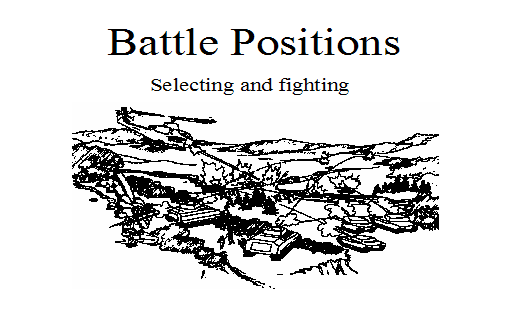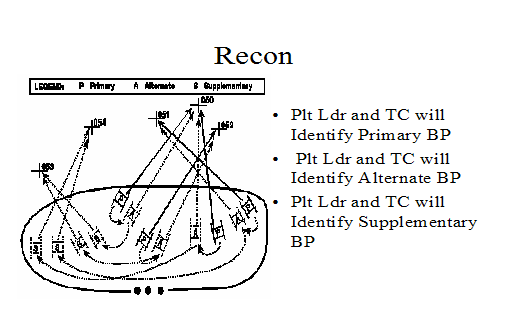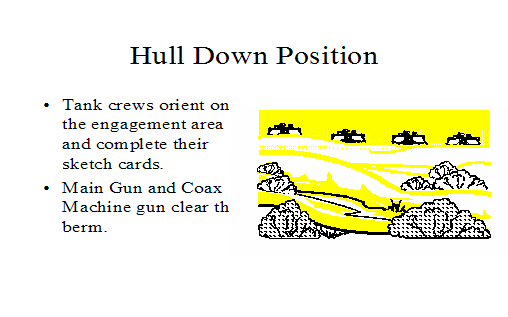Battle Positions Selecting and fighting
Click here to download the presentation.



Battle Positions
Selecting and fighting
DEFENSIVE OPERATIONS
The immediate purpose of any defensive operation is to defeat an enemy attack. Military forces defend until they gain sufficient strength to attack. Additionally, defensive operations are undertaken to gain time, to hold key terrain, to preoccupy the enemy in one area so friendly forces can attack elsewhere, and to erode enemy resources at a rapid rate while reinforcing friendly operations.
3 Levels of Preparation of a Platoon Battle Position
Reconnoiter – A ground or map recon
Prepare – Planning and preparation phases
Occupy – the complete preparation of the BP
PLANNING
It is critical that the platoon leader understands where the commander wants to kill the enemy.
It is also essential that he identify platoon sectors of fire and tentative platoon BP’s as well as TRP’s that define the company engagement area.
Primary Concerns of the PLT
Select fighting positions that allow the Platoon to concentrate and mass lethal fires into designated sectors of fire.
Conditions needed for a Deliberate Defense
Adequate time is available
The enemy is not expected or has not been located within direct fire range
A friendly element forward of the BP provides security for the platoon
Moving to Hide Position
Conduct a Tactical movement to the Hide Position
Assume a Herringbone formation and establish local security
Vehicles occupy and Shut down simultaneously
Preparing for a Recon
PL briefs reconnaissance group
PSG designates, briefs, and inspects security element
PL designates NCOIC for elements left in the hide on the following
Security and Maintenance
Contingency plan in event of enemy contact
Preparing for a Recon cont.
PL, PSG, and security element move to the BP
Conducting Reconnaissance
PL, PSG, TCs, and security element mark the BP covering the following elements
Engagement Area
General layout of the BP and surrounding terrain
Key Terrain corresponding to the Platoons graphic control measures
OP locations to cover possible enemy avenues of approach
Conducting Reconnaissance cont.
Existing obstacles and possible locations for reinforcing obstacles
Key locations in the BP and Engagement area marked using limited visibility materials
Following the Reconnaissance of the BP and surrounding area, confirms, reviews the following
Company team scheme of maneuver
Conducting Reconnaissance cont.
Platoon scheme of maneuver, to include trigger points, break points, and disengagement/displacement criteria
Platoon sector of fire
Covered and concealed routes into, out of, and within the BP and to subsequent BPs
Conducting Reconnaissance cont.
PL emplaces Ops as necessary and briefs the following
Overwatch responsibilities
Contingency plans, covering actions to be taken if the platoon does not return on time or enemy contact
Displacement criteria and signals
Conducting Reconnaissance cont.
PL coordinates with adjacent units and confirms the following
Location of OP
Overlapping sectors of observance and direct fire
Dead space
Locations and types of obstacles
Indirect fire data
Conducting Reconnaissance cont.
Communications information and procedures
Routes into, out of, and between platoon and adjacent unit BP
Reconnaissance group moves back to the Hide
Recon
Plt Ldr and TC will Identify Primary BP
Plt Ldr and TC will Identify Alternate BP
Plt Ldr and TC will Identify Supplementary BP
Subsequent and Supplementary BP
Subsequent BP’s are those that orient on sectors of fire along the same avenue of approach as the primary/alternate positions.
Supplementary BP’s are orientated on sectors of fire along different avenues of approach.
Occupying the BP
Vehicles start simultaneously and move covered and concealed routes to the Hide positions on Order
On PL order vehicles move simultaneously into turret-down positions “LOWSKY”
Turret Down Position
Position allow the tanks to fire only their caliber .50 or loader’s M240 machine gun.
Occupying the BP cont.
On PL orders vehicles move simultaneously into hull-down positions “TOPHAT”
Hull Down Position
Tank crews orient on the engagement area and complete their sketch cards.
Main Gun and Coax Machine gun clear the berm.
Occupying the BP cont.
TCs and gunners develop vehicle sketch cards
Once sketch cards are completed vehicles back down to hide positions and shut down their engines
TCs provide a copy of sketch cards to the PL
Occupying the BP cont.
PL consolidates the sketch cards and finalizes the platoon fire plan
Platoon Sketch Card
Individual tank positions.
Platoon sector or engagement area.
TRPs.
Range lines, trigger points, and break points (these may coincide).
OPs (if used).
Obstacles (if used).
Indirect fire targets, including final protective fires (FPF), if allocated.
Dead space.
Improving the BP
PL updates the platoon and commander on changes to the occupation plan and implements actions to complete occupation
Changes as a result of coordination and commanders guidance
Vehicle maintenance and prep to fire checks
Improving the BP cont.
PL directs and/or supervises improvement activities
Establish thermal TRPs
Locations of M8/M8A1
Emplacement of obstacle IAW Cos guidance
Emplacement of decoys
Improving the BP cont.
PSG conducts following improvements
Camouflaging of vehicles and equipment
Installation of Hotloop
Direct emplacement of prestock ammunitions and other supplies
Improving the BP cont.
TCs conduct the following
Ensure that vehicle positions afford clear fields of fire
If engineers are available, supervise and proof construction of dug-in fighting positions
Direct emplacement of M8/M8A1 alarms
Selecting Battle Position
TC should be responsible for the improvement of his firing position.
He must ensure the location, orientation, and depth of the hole are correct before the engineer departs for the next fighting position.
He should also be aware of the importance of selecting a site with a background that will break up the silhouette of his vehicle this helps to prevent skylining.
Completing Occupation
Conduct rehearsals
Special rehearsal (individual/crew tasks)
Map rehearsal
Communications rehearsal
Key Leader rehearsal
Sand table/terrain model rehearsal
Force on force rehearsal
Rehearsal with all crews observing designated platoon vehicle as it moves in the engagement area
Completing Occupation cont.
Complete occupation activities and priorities of work
Complete the occupation to ensure the platoon is prepared to defend by the time specified
Execute the Defense